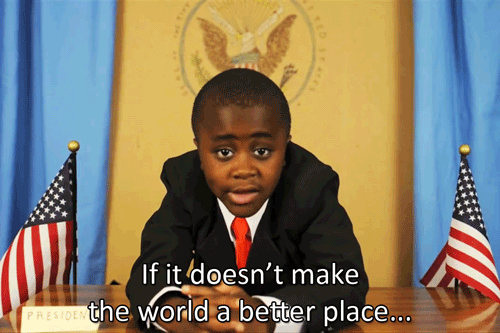In a time of universal deceit telling the truth is a revolutionary act - George Orwell
Don't wanna be here? Send us removal request.
Photo
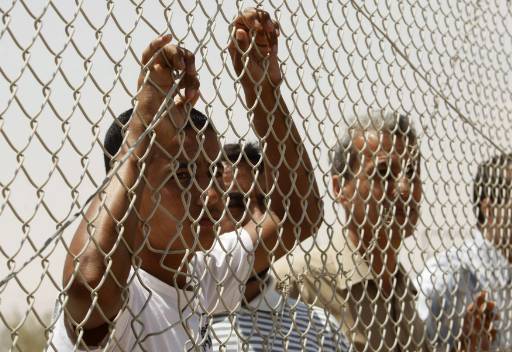
Palestinian minister urges Egypt to re-open Rafah
Palestinian government’s health minister Mufid al-Muhallelati says “the problems in health sector in Gaza are at a level of crisis” after the closure of Rafah border gate.
World Bulletin/News Desk
Palestinian government’s health minister Mufid al-Muhallelati says “the problems in health sector in Gaza are at a level of crisis” after the closure of Rafah border gate.
Muhallelati told a press conference that his ministry and affiliated institutions were dramatically affected after the border gate was closed by Egyptian authorities on 11 September due to security concerns.
Following the closure of the gate, pharmaceutical stocks went down by 30 per cent and patients cannot be treated due to lack of medical supplies.
Palestinian health minister stated that they carry on medical operations together with some international organizations such as Turkish Red Crescent and TIKA (Turkish Cooperation and Coordination Agency), urging the international society to put pressure on Israeli state to end the blockade on Gaza and permit medical supplies and basic construction materials to enter Gaza. Muhallelati also urged Egypt to re-open Rafah border gate.
Rafah border gate was closed by Egypt on 11 September by Egyptian authorities due to security concerns following a military coup against President Mohamed Morsi and the tunnels used by Palestinian people to get into Egypt to provide vital supplies were also mostly destroyed by Egyptian forces.
Rafah is the only border gate into Gaza, a city under a strict Israeli blockade since 2006.
Approximately 1.8 million people live in Gaza.
3 notes
·
View notes
Photo

Israeli occupation leaves psychological not just physical scars
Palestine is a nation shaped by its arid scenery and history as the holy land. However, since 1948, it has also been defined by the scar of occupation.
A separation wall, ugly and gray, now blights the land which many believe Jesus walked on. It is perhaps one of the most sacrilegious and grotesque structures existing today.
This wall is the very embodiment of the illegal occupation of the West Bank. It serves as a reminder every day, in every place, that Palestinians are not yet free, despite the promises made at Oslo in the mid ’90s and then later at Camp David.
Within the parameters of the wall, however, exists a more subtle (and perhaps more damaging) form of occupation.
The West Bank city of Nablus rests between two hills. The city center is perennially busy, with people going about their daily business, running mundane errands.
At first glance, there is nothing unusual about Nablus. In many ways it’s a great tourist destination; it has a bustling old city, friendly people and beautiful surroundings. It is easy to forget, or even to remain oblivious of, the fact that Nablus is occupied.
Constantly observed
In reality, occupation surrounds the city. On one side there is a settlement, inhabited by radical Zionists. On the other, there’s an Israeli military base, silently watching over the city. Nablus is constantly being observed.
While the impact of the occupation on the landscape is relatively subtle, its psychological impact on the residents of Nablus is significant. Many have lost friends and family to the settlers or army.
One resident, who we shall call N, described to me how his friend had been killed by the army on one of the hilltops. N and his friends had to wait for a whole day to pick up the body, and only then with the help of international activists, whose plaintive requests, screamed from megaphones, were arguably the only thing separating N and his friends from meeting the same fate as the body they were trying to collect.
The occupation by observation becomes a lot more visceral as night falls. At around midnight (although sometimes it can be as early as 10:30pm) the settlers (backed by the Israeli army) descend upon the city.
They are confronted by young Palestinian men, who throw stones. They are met with tear gas canisters, live ammunition and sound bombs.
It is an exercise in symbolically reclaiming and defending space. The army and settlersinvade to remind the residents of Nablus that they are not secure.
As soon as night falls, Nablus becomes a contested space. During the nightly battles, no ground is lost or gained. The purpose is purely to violate. To assert control. To serve as a reminder that life continues as normal in the daylight only because the Israeli army allows it to be so.
The invasion of space is a form of humiliation, to replace checkpoints and the continuous presence of Israeli soldiers. It is like an assault, felt by everyone in Nablus — serving as a reminder of their subjugation.
Humiliation of this kind is present almost everywhere in the West Bank.
Nowhere, however, is this abasement more present than in the southern city of Hebron. Divided into two parts, the city is subjected to some of the most violent and radical settlers within the West Bank.
Profane
As a result, Hebron is notorious for extremely visible signs of apartheid; checkpoints, streets off-limits to Palestinians, houses which must have their doors open all day and all night in case Israeli soldiers need to enter onto the roof to gain a better vantage point.
Nonetheless, these are not the most profane symbols of the occupation. It is the everyday humiliations, carried out at the hands of the Israeli army, that are the most sickening aspect of the situation in Hebron.
To access the Ibrahimi Mosque, Palestinians must walk through a revolving gate. It is a de facto checkpoint.
People walk towards the jaws of this gate in single file, shuffling along like cattle, under the watchful eye of an impossibly young soldier. Occasionally the gate jams (or is purposefully turned off by the soldiers, depending on who you believe).
Everyone must wait for it to start working, held in a state of suspended animation. It is an incredibly dehumanizing experience. You are alone. You are watched.
The humiliation endured by the Palestinians in the West Bank and Gaza is the ugliest form of structural violence. It reinforces the message, day in and day out, that they are a subjugated people.
It is completely deliberate, a tactic of psychological warfare which is being utilized by the Israeli army, rather than the unfortunate side-effect of necessary security measures. The ability of an 18-year-old Israeli soldier to disrupt the day of a Palestinian family reinforces the ethnic hierarchy which places Israelis above Palestinians. It reifies the power structures of the Israeli state.
Trauma
It should be more widely recognized that this is a form of psychological warfare — the occupation is an occupation of the mind as well as the land. The intention is to create a submissive populace by breaking its spirit.
There are signs of a cracked collective psyche in Hebron, particularly among the children. An 11-year-old boy recounted to me the story of how the Israeli soldiers at one of the town’s military checkpoints had delayed his mother getting through with his sick baby brother.
Five minutes before the soldiers let her through, the baby had died. He told the story in a tone of complete hopelessness.
He finished off by saying that nobody cared because his family were Palestinians.
In 2011, Médecins Sans Frontières and Palestinian mental health groups reported that in Nablus in particular, high levels of anxiety disorders among children are being attributed to chronic settler harrassment and Israeli military incursions. And elsewhere across the West Bank, children are “overwhelmingly” suffering from post-traumatic stress disorder, the groups stated.
Standing in solidarity with the Palestinian struggle necessitates more than going on a demonstration after Israel launches air strikes on Gaza, or attacks a refugee camp in the West Bank. There remains a need to draw attention to the structural violence of the Israeli occupation — it is indeed a form of violence, as morally reprehensible as the bombing of a civilian population.
We must not focus our fight solely on the physical salvaging of Palestine. This is not simply a battle for land, it is a battle against the oppression of the mind as well as the body.
Alia Al Ghussain is an Anglo-Arab who was born and raised in Dubai. She is pursuing a masters degree in human rights at the University of Sussex.
3 notes
·
View notes
Text
Gaza heads to an environmental disaster
The Gaza Strip is suffering from a spiraling fuel crisis that is affecting almost all sectors in the already impoverished territory.
The Minister of local government Mohammed al -Farra announced this week the wastewater treatment plant stopped functioning and the municipalities are going to pump the sewage water into the sea. The main reasons behind such a situation is the shortage of fuel coming from Egypt after its tightening of the security measures along the borders with Gaza and the high costs and small amount of fuel coming from the Israeli side. Carrying away sewage water into the sea results in polluting not only the water, but also the soil and the soil adjacent to Gaza shores which negatively impacts the fishing industry. In addition to the wastewater treatment plant, the Minister of the local government announced in a statement that all Gaza municipalities will stop functioning next Thursday because of the lack of fuel. Gazans expect the international community to shoulder its legal and humanitarian responsibilities, to immediately act to provide the Gaza Strip with its basic needs of electrical supplies and fuel. The fuel crisis is leading to an imminent humanitarian and environmental disaster, as it has started to cripple the vital sectors in the Gaza Strip.
0 notes
Photo

War becomes perpetual when it is used as a rationale for peace
1 note
·
View note
Photo
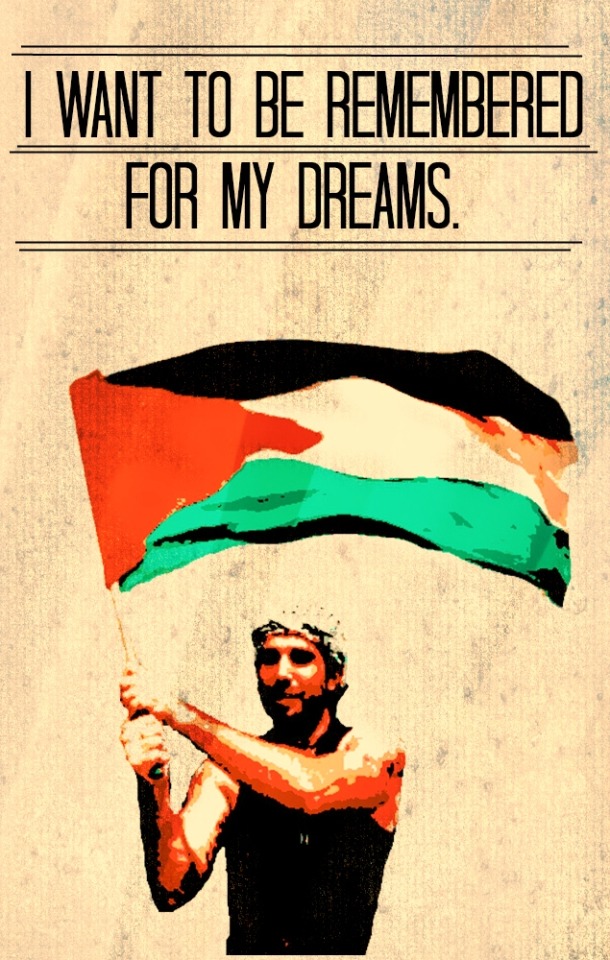
I made this poster type thing of Vittorio Arrigoni, who was an Italian peace activist.
That’s a quote from him by the way, in case you didn’t guess.
105 notes
·
View notes
Photo

اصنع حريتك وطير
Get your freedom and fly
64 notes
·
View notes
Photo
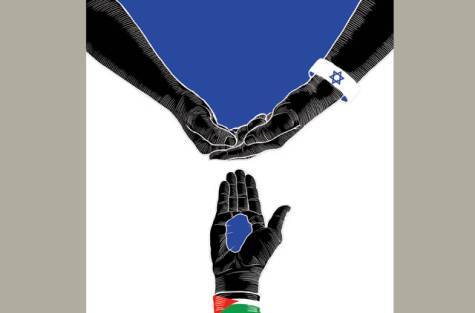
The two state solution died over a decade ago
Israel continues to look for more Oslos to gain international legitimacy...
The recent attempt to revive the peace talks between Israel and the Palestinians is not likely to produce more meaningful results than that of any of the previous attempts. It comes 20 years after the Oslo Accords were signed between Israel and the Palestine Liberation Organisation.
The Oslo Accords were a twofold event. There was the Declaration of Principles (DoP) signed ceremoniously on the White House lawn on September 13, 1993; and there was the relatively less celebrated ‘Oslo II’ agreement signed in September 1995 in Taba, Egypt, which outlined the implementation of the 1993 DoP, according to their Israeli interpretation.
The Israeli interpretation was that the Oslo Accords were merely an international as well as a Palestinian endorsement of the strategy the Israelis had formulated back in 1967 vis-à-vis the occupied territories. After the 1967 war, all the successive Israeli governments were determined to keep the West Bank as part of Israel. It was, for them, both the heart of the ancient homeland and a strategic asset that would prevent the bisection of the state into two should another war break out.
At the same time, the Israeli political elite did not wish to grant citizenship to the people living there, nor did they seriously contemplate their expulsion. They wanted to keep the area, but not the people. The first Palestinian uprising, however, proved the cost of the occupation, leading the international community to demand from Israel a clarification of its plans for the future of the West Bank and the Gaza Strip. For Israel, Oslo was that clarification...
12 notes
·
View notes
Video
youtube
The Story of Palestine...
...The story of Palestine and its people is one that will go down in history. In fact it has already started to do just that. One might say that the victor is the one that writes history. The victor in this case will inevitably be justice, and justice is at the core of the Palestinian struggle against apartheid, colonialism and oppression...
2 notes
·
View notes
Photo
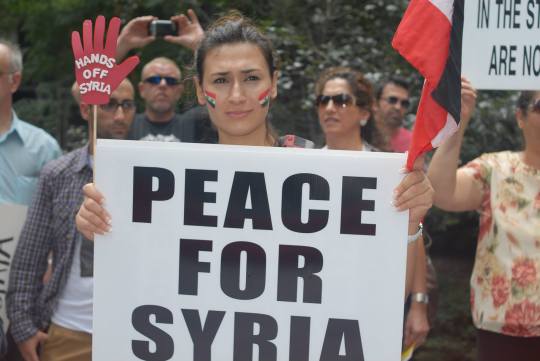
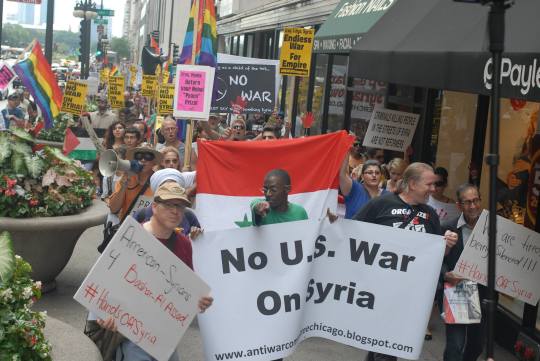

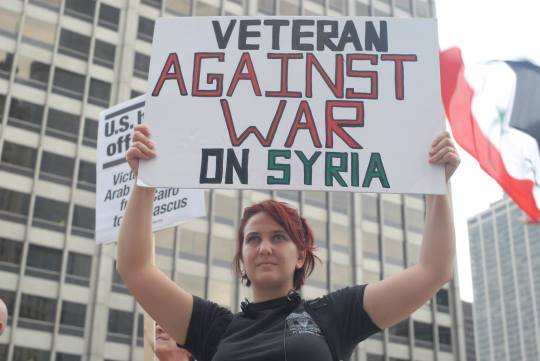
Chicago: Hundreds march to demand “Hands Off Syria,” September 6, 2013.
Photos by Christine Geovanis
314 notes
·
View notes
Photo

Number of Americans living in poverty remains steady
The Census Bureau in its annual report said about 46.5 million Americans were living in poverty last year, little changed from 46.2 million in 2011...
How ironic that a world power like the US can send billions of dollars to fight wars in other countries but fails to spend money on decreasing the poverty levels of her own people.
0 notes
Text
U.S. media suppressed 2009 UN report showing Israel using chemical weapons against Palestinians
Obama ignores Israel's chemical weapons abuse while targeting Syrian government that may not be responsible for recent chemical attacks
NEW YORK, NY – Few major mainstream American news outlets exposed the sordid details of a 2009 United Nations (UN) fact finding report that revealed how Israel’s military illegally aimed chemical missiles at a United Nations Relief & Work Agency (UNRWA) for Palestinian refugees in a 22-day invasion of the Gaza strip that began in 2008 called “Operation Cast Lead.”
As the U.S. and world media watch to learn if claims that President Barack Obama will execute a military strike against Syria, without a vote of Congress or the support of the UN, the same media outlets are burying information that suggests preparation for war could be premature. Little media attention is being paid to claims from a UN commission that Syrian rebels, not government soldiers under President Bashar al-Assad’s control, were responsible for recent chemical weapons attacks that killed over 300 Syrians.
“During our investigation for crimes against humanity and war crimes, we collect some witness testimony that has made to appear that some chemical weapons were used. In particular, nerve gas,” said Carla del Ponte, a member of the U.N. Independent International Commission of Inquiry on Syria. ”What appears to our investigation is that this was used by the opposition, by the rebels. We have no indication at all that the Syria government have used chemical weapons.”
What’s also questionable is why Obama has drawn a “line in the sand” over highly questionable allegations that Syrian soldiers used chemical weapons when the Israeli military was proven, and officials have admitted, to using chemical warfare to attack a United Nations relief compound. The facility provided shelter and medical attention to Palestinian refugees in 2009.
Cleveland Challenger obtained a copy of the 575 page 2009 UN report that a fact finding mission headed by ex-South African Judge Richard Goldstone prepared after an investigation of the events surrounding Operation Cast Lead.
The Israeli missile and ground assault on the Gaza strip began on December 27, 2008 and ended on January 18, 2009. The attack resulted in an estimated 1100 to 14oo Palestinian deaths. 13 Israeli soldiers were killed. Four died from friendly fire.
The invasion was stimulated by Israel’s claims that rockets were being fired at Israeli’s by Hamas militants. Three Israeli civilians and one soldier were killed by Hamas’ rockets in the days leading up to the assault that led to an estimated $1.3 billion in damage to Palestinian property and businesses. Israel’s military was also accused by the UN fact finding mission of violating war protocols by using Palestinians as human shields, murdering unarmed civilians, destroying water and sewer treatment plants, and wiping out food supplies and production facilities to starve the population.
The UN commission Goldstone led met extensively with Palestinian officials, victims and survivors after the Israeli military assault. The interviews and investigation led to the discovery of information and evidence that Israel’s military deployed missiles containing “white phosphorous” against civilians and the hospital.
White phosphorous is a highly-combustible chemical agent that burns on contact with air. In humans it burns upon contact with skin and creates very deep tissue wounds. It can also cause death when inhaled. It’s customary use has been as a “smoke screen” although it is illegal to use against civilians in times of war. The UN commission found Israel’s use of the burning agent against the hospital to be particularly deplorable.
When first questioned about the white phosphorous missile allegations that struck the UNRWA compound, the Israeli military’s first response was to issue a denial. On January 15, 2009, three days before the attack ended, Israeli Defense Minister Ehud Barak called the chemical weapon attack a “grave error” and allegedly apologized to UN Secretary General Ban Ki Moon. On the same day, Israeli President Shimon Peres apologized for the attack, but added the false claim that Israeli troops were being fired upon from inside the facility....
Graphic image.
0 notes
Photo

#Palestinian Kids, Cute & Brave
115 notes
·
View notes
Photo

Guided and Misguided #Syria
515 notes
·
View notes
